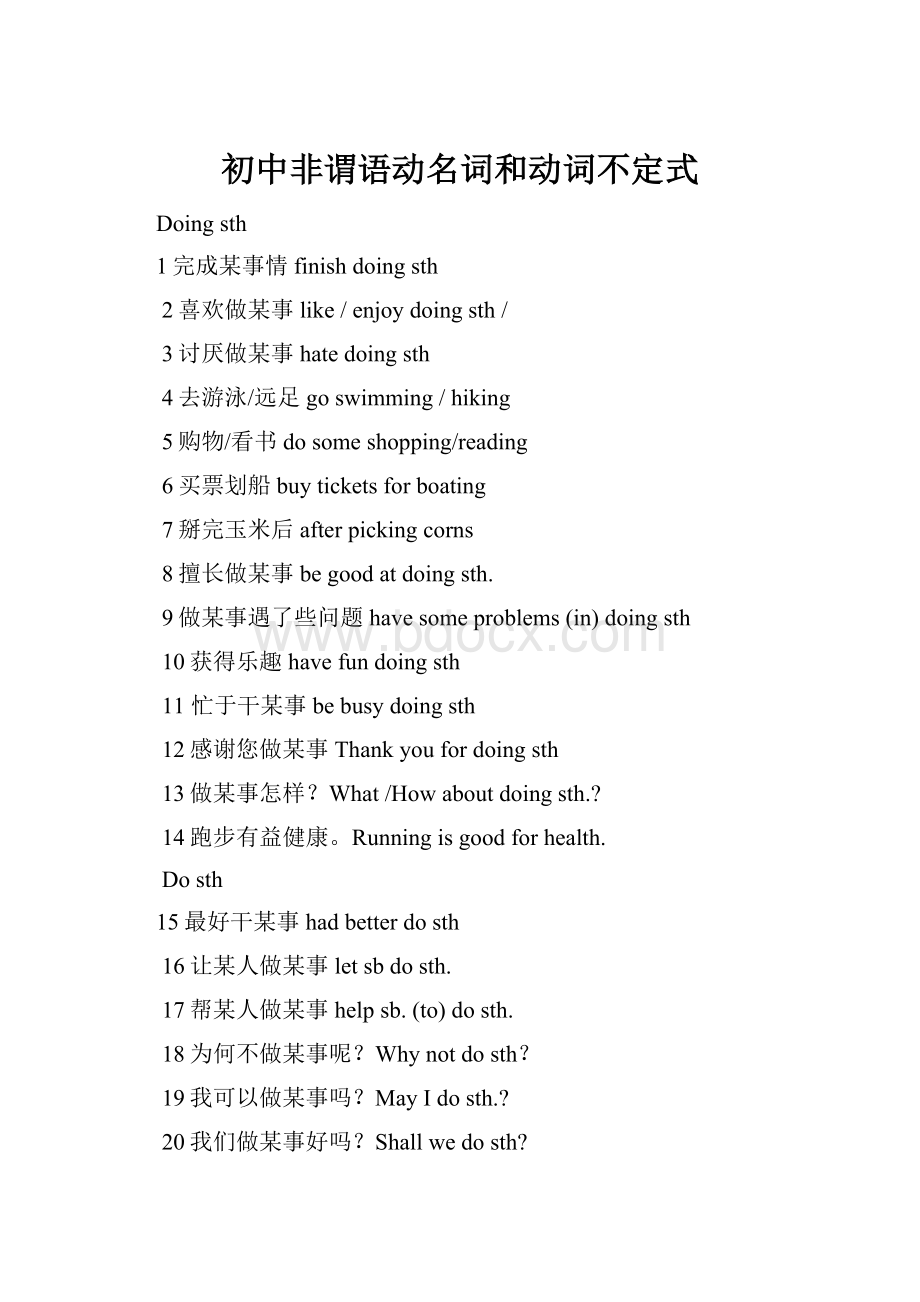初中非谓语动名词和动词不定式.docx
《初中非谓语动名词和动词不定式.docx》由会员分享,可在线阅读,更多相关《初中非谓语动名词和动词不定式.docx(20页珍藏版)》请在冰豆网上搜索。

初中非谓语动名词和动词不定式
Doingsth
1完成某事情finishdoingsth
2喜欢做某事like/enjoydoingsth/
3讨厌做某事hatedoingsth
4去游泳/远足goswimming/hiking
5购物/看书dosomeshopping/reading
6买票划船buyticketsforboating
7掰完玉米后afterpickingcorns
8擅长做某事begoodatdoingsth.
9做某事遇了些问题havesomeproblems(in)doingsth
10获得乐趣havefundoingsth
11忙于干某事bebusydoingsth
12感谢您做某事Thankyoufordoingsth
13做某事怎样?
What/Howaboutdoingsth.?
14跑步有益健康。
Runningisgoodforhealth.
Dosth
15最好干某事hadbetterdosth
16让某人做某事letsbdosth.
17帮某人做某事helpsb.(to)dosth.
18为何不做某事呢?
Whynotdosth?
19我可以做某事吗?
MayIdosth.?
20我们做某事好吗?
Shallwedosth?
21请不要做某事。
Please(don't)dosth.
Todosth
22不得不做某事havetodosth.
23尽力干某事trytodosth
24将要干某事begoingtodosth.
25想做某事wanttodosth
26无所事事havenothingtodo
27需要干某事needtodosth
28打电话告诉你calltotellyou
29想要某人去干某事wantsbtodosth
30使用…干什么usesthtodosth
31告诉某人(不)要干某事tellsb(not)todosth
32乐于干某事begladtodosth
33过来做某事come(up)todosth.
34考虑说什么thinkaboutwhattosay
35参观中国的最好时间thebesttimetovisitChina
36我有许多工作要做。
Ihavealotofworktodo.
37没时间去干某事。
There'snotimetodosth
38对于某人来说干某事…It's形forsbtodosth
39干某事花费某人一些时间Ittakessbsometimetodosth
40干某事很好It'sgoodtodosth
41我的工作是喂牲口。
Myjobistofeedtheanimals.
42听到这种事我很伤心I'msorrytohearthat
43你愿意做某事吗?
Wouldyouliketodosth?
Todo/Doingsth
44开始做某事starttodo/doingsth
45忘记/记得干某事forget/remembertodosth.
46忘记/记得干过某事forget/rememberdoingsth.
47继续做某事(未完)goondongsth.
48继续做某事(另事)goontodosth.
49听/看见某人在干某事hear/seesbdoingsth.
50听/看见某人干了某事hear/seesbdosth.
51停止做某事stopdoingsth.
52停下来做某事stoptodosth.
初中非谓语动词句型归纳
根据《九年义务教育全日制初级中学英语教学大纲》的要求,初中阶段,只要求学生掌握非谓语动词中的动词不定式基本用法,但是,在中考中,非谓语动词其它形式的固定结构也是考查的重点,为了帮助同学们系统掌握这一语法重点,本文就初中英语非谓语动词的句型及固定配搭归纳如下:
一.动词不定式
1.主语+decide(hope,agree,choose,fail,wish,learn等)+todosth.例如:
Ihopetogotoschoolnextweek.
Sheagreetogetsomeonetohelpher.
2.主语+ask(tell,get,wish,like,want,teach,know等)+宾语+todosth.例如:
Heaskedmetocomehereearly.
Shetoldusnottoworryabouther.
3.主语+be+happy(glad,pleased,angry,sorry,careful,ready,nice,lucky,等)+todosth.例如:
I'mgladtoseeyouagain.
I'msorrytohearthat.
4.主语+think(make,fine,feel等)+it+形容词(名词)+todosth.例如:
IfounditveryimportanttolearnEnglishwell.
Ithinkitpossibletofinishtheworkthisweek.
5....too+形容词(副词)+(forsb.)+todosth.
...+形容词(副词)enough+todosth.例如:
Theboyistooyoungtogotoschool.=
Theboyisnotoldenoughtogotoschool.=
Theboyissoyoungthathecan'tgotoschool.
6.It's+careful(clever,kind,good,right,wrong等)+ofsb.+todosth.
It's+difficult(easy,hard,important,interesting等)+forsb.+todosth.例如:
It'skindofyoutohelpme.
It'shardforyoutolearnEnglishwell.
注意:
这两个句型的区别是,当somebody与形容词有逻辑上的主谓关系时用of;当somebody与形容词没有这种关系时用for。
7.Ittakessb.sometime+todosth.这个结构中,It是形式主语,真正的主语是
后面的动词不定式结构。
例如:
Ittookmeaboutthreehourstofinishmyhomeworkyesterday.
注意:
表示“花费”的类似句型还有,Sb.spendssometime(money)onsth.or(in)doingsth.(某人做什么用了多少时间/某人买什么花了多少钱);Sth.costssb.somemoney.(买什么花了某人多少钱);Sb.payssomemoneyforsth.(某人买什么花了多少钱)如:
Ispentanhourson(indoing)myhomework.Thepencostmetwoyuan.Ipaidtwoyuanforthepen.
8.疑问词+todosth.例如:
Idon'tknowwhentoholdtheparty.
Howtodoitisstillaquestion.
9.Why+(not)dosth.…,Would(Will)youplease(not)dosth.和hadbetter(not)dosth.例如:
Whynotgotherebybike?
WouldyoupleasetakemetotheparkthisSunday?
You'dbetternotgotherebyyouself.
10.主语+feel(listento/hear,let/make/have,see/watch/notice/lookat/help)+宾语+dosth.例如:
Hemadeusworkforalongtimeyesterday.
Whohadyoubesocareless?
注意:
hear,see等感觉动词常接doingsth.表示动作发生过程或强调和谓语动作同时发生。
如:
HesawTomsittingonsomeeggswhenhewentintotheroom.
IheardhersingingasongwhenIpassedherroom.
11.主语+like/love/hate/begin/start等+todosth.(doingsth.)例如:
Tomlikestoask(asking)somestrangequestions.
Webegintowork(working)atseveneveryday.
12.主语+remember/forgettodosth.记住(忘记)要做某事(动作还没发生)
主语+remember/forgetdoingsth.记住(忘记)曾做过某事(动作已发生)
主语+stoptodosth.停下来(正做的事)去做另一件事
主语+stopdoingsth.停下正做的事
主语+trytodosth.设法(试图)去做某事
主语+trydoingsth.试着做某事例如:
Don'tforgettoclosethedoorwhenyouleave.
Iforgottakingwhosebook.
初中英语:
非谓语动词
非谓语动词指的是在句中起名词,形容词或副词作用的动词形式,而不是作谓语的动词形式。
动词的非谓语形式分为动名词,分词,动词不定式。
Climbingmountainisagoodexercise.(Climbing...,动名词起名词作用)
爬山是一项好运动。
Doyouknowthemanwearingawhiteshirt.(wearing...分词起形容词作用)
你认识那个穿白衬衣的人吗?
Hegetsupearlytocatchthefirstbus.(tocatch....不定式起副词作用)
他早早起床是为了赶上第一班汽车。
1.谓语动词和非谓语动词的区别:
1)谓语动词在句中可单独作谓语,而非谓语动词不能单独作谓语。
MissMaryteachesusEnglish.
玛丽教我们英语。
(teaches动词作谓语)
Mr.Victorcametoourclassroomtohaveatalkwithuslastweek.
维克托先生上周来到了我们教室和我们谈话。
(tohaveatalk....不定式作状语)
2)谓语动词受主语的人称和数的限制,而非谓语动词形式没有这种限制。
Larkelikesthepopmusic.
拉克喜欢流行音乐。
(动词用单数第三人称形式)
Larkehasnothingtodotoday.
拉克今天没什么事要做。
(do用原形)
非谓语动词的特征:
1如果非谓语动词是及物动词,后面须跟宾语。
StudyingEnglishismyfavorite.
学习英语是我的爱好。
(studying后跟宾语)
Tohelphimismyduty.
帮助他是我的责任。
(help后跟宾语)
2非谓语动词可以带有自己的状语或逻辑主语。
Workingundersuchaconditionisterrible.
在这样的环境下工作太可怕了。
(undersuchacondition是working的状语)
It'stoodifficultforhimtomasterEnglishinsuchashorttime.
他在这么短的时间内掌握英语太难了。
(forhim作不定式的逻辑主语)
3非谓语动词仍有语态和时态的变化。
Iamsorrytohavekeptyouwaitinglong.
对不起让你久等了。
(tohavekept...是不定式的完成形式)
Seenfromthemountain,thecitylooksmuchmorebeautiful.
从山上看,这座城市美丽多了。
(Seenfrom...是分词的被动形式)
4非谓语动词在句中可以当成名词或者形容词来使用。
Ourcomingmadehimhappy.
我们的到来使他很高兴。
(coming起名词作用)
Therearetwobigswimmingpoolshere.
这儿有两个大型游泳池。
(swimming起形容词作用)
2.非谓语动词的形式变化:
不定式主动被动
一般towritetobewritten
进行tobewriting/
完成tohavewrittentohavebeenwritten
完成进行tohavebeenwriting/
现在分词主动被动
一般writingbeingwritten
完成havingwrittenhavingbeenwritten
过去分词一般written
动名词 主动被动
一 般 writingbeingwritten
完 成 havingwrittenhavingbeenwritten
3.动词不定式:
3.1动词不定式在句子中的作用
动词不定式是由to+动词原形构成,在句中起名词,形容词和副词的作用,可以担任除谓语以外的其它任何成分。
3.1.1动词不定式作主语:
Tomastalanguageisnotaneasything.
掌握一门语言不是一件容易的事情。
ToteachEnglishismyfavorite.
教英语是我的爱好。
It'smypleasuretohelpyou.
很乐意帮助你。
动词不定式作主语时可以放在后面,而用it作形式主语放在原主语的位置上。
It'sverykindofyoutohavegivenusmuchhelp.
你给了我们那么多的帮助真是太好了。
It'snecessarytofindthewitness.
有必要找到目击者。
3.1.2动词不定式作宾语:
某些及物动词可以用动词不定式作宾语,这些动词有decide,begin,help,begin,want,wish,like,forget,learn,ask.
WhatIwishistolearnEnglishwell.
我所希望的是把英语学好。
IliketohelpothersifIcan.
如果有可能的话,我喜欢帮助别人。
3.1.3动词不定式作宾语补语。
Weexpectyoutobewithus.
我们希望你和我们在一起。
Pleaseaskhimtocomeherequickly.
请叫他快过来。
3.1.4动词不定式作表语:
WhatIshoulddoistofinishthetasksoon.
我应该做的是赶快完成任务。
Themosturgentthingistofindtheboyimmediately.
当务之急是马上去找孩子。
3.1.5动词不定式作定语:
Therearemanywaystosolvetheproblem.
有许多方法能解决这个问题。
Ihavesomethingimportanttotellyou.
我有重要的事情要告诉你。
3.1.6不定式作状语:
Wewenttothehospitaltoseeourteacher.
我们去医院看了我们的老师。
SheismakingatesttogetakindofusefulmedicinefromaTibetflower.
她在做试验,从一种西藏花中提取某种有用的药物。
3.2动词不定式的否定形式:
not+to+动词原形
Theteachertoldusnottoswiminthatriver.
老师告诉我们不要在那条河里游泳。
It'sunfairnottotellus.
没告诉我们真是不公平。
3.3带疑问词的不定式:
疑问词who,what,which,when,where,how,why可以加在不定式的前面,构成不定式短语,使含义更加具体。
Wheretogoisnotknownyet.
去什么地方还不知道。
Idon'tknowwhentobegin.
我不知道什么时间开始。
Canyoutellmewheretogetthebattery.
你能告诉我哪儿能买到电池吗?
Doyouknowhowtogettothestation.
你知道怎样去车站吗?
3.4带逻辑主语的不定式:
动词不定式可以带有自己的逻辑主语,构成方法是:
for+逻辑主语+不定式。
注意:
逻辑主语用宾格形式,for本身无实际意义,它只表明后面的主语从逻辑上分析是不定式的主语。
It'snecessaryforustohelpeachother.
我们互相帮忙是必要的。
Therearemuchworkformetofinish,
有许多工作要我去完成。
3.5动词不定式的时态:
动词不定式一般时:
表示动作和句中谓语动词的动作同时发生或之后发生。
Ihelpedhimputthethingsintothecar.
我帮助他把东西放进了汽车。
Iwanttoseeyouagain.
我想再见到你。
Wouldyouliketohavearest.
你愿意休息一下吗?
动词不定式完成时:
表示动作在句中谓语动词的动作之前发生。
Wearesorrytohavekeptyouwaitingsolong.
对不起,我们让你久等了。
Theyseemstohaveknowntheanswers.
他们好像知道了答案。
动词不定式进行时:
表示动作同句中谓语动词的动作同时发生,强调动作正在进行。
Theyseemtobeworkinghard.
他们好像在努力工作。
3.6动词不定式的被动形式:
表示不定式动词同所修饰的名词是被动关系。
Heisthemantobeexamined.
他是受检查的人。
Therearemuchworktobedone.
有好多工作要做。
4.动名词
4.1动名词在句中的作用
动名词是由动词原形+ing构成,同现在分词形式一样,在句中可作主语,宾语,表语和定语。
4.1.1动名词作主语:
Talkinglikethatisnotpolite.
那样谈话不礼貌。
Learningfromothersisimportant.
向别人学习很重要。
Puttingonmoreclothesisnotsogood.
多穿衣服不一定好。
动名词可以象动词不定式一样,用it先行祠代替,而把动名词写在后面。
It'snousewaitinghere,let'sgohome.
在这儿等着也没用,我们回家吧。
It'sverydifficultclimbingthismountain.
爬这座山很困难。
4.1.2动名词作表语
Thenurse'sjobislookingafterthepatients.
护士的工作是护理病人。
Seeingisbelieving.
眼见为实。
4.1.3动名词作宾语
有些动词须用动名词来作宾语,它们是begin,mind,suggest,finish,stop,need,enjoy,miss,keep.
Pleasestopsmokinginthehouse.
请不要在家里抽烟。
Ilikereadingintheforest.
我喜欢在树林里读书。
Doyoumindmyopeningthewindows?
你介意我打开窗户吗?
Sheisfoundofcollectingstamp.
她喜欢集邮。
4.1.4动名词作定语
Sheisstudyinginthereadingroom.
她在阅览室学习。
Hesleptinthesleepingbag.
他在睡袋里睡觉。
动名词的否定形式:
not+动名词
Hepretendnotknowingitatall.
他假装全然不知。
Weconsiderednotdoingitnow.
我们考虑现在不做这件事。
4.2动名词的时态:
动名词的一般时动名词的一般时表示动作与句中谓语动词的动作同时发生,或在谓语动词的动作之后发生。
Ienjoyswimminginthebigriver.
我喜欢在大河里游泳。
IamusedtowatchingTVintheevening.
我习惯于晚上看电视。
动名词的完成时动名词的完成时表示动作在谓语动词动作之前发生。
Sheregretnothavingstudiedthecomputerhard.
她后悔没有努力学习计算机。
Doyourememberhavingpromisedmethat?
你记得给我许愿了吗?
4.3动名词的被动形式:
当动名词和它的逻辑主语是被动关系时,用动名词的被动形式来表示。